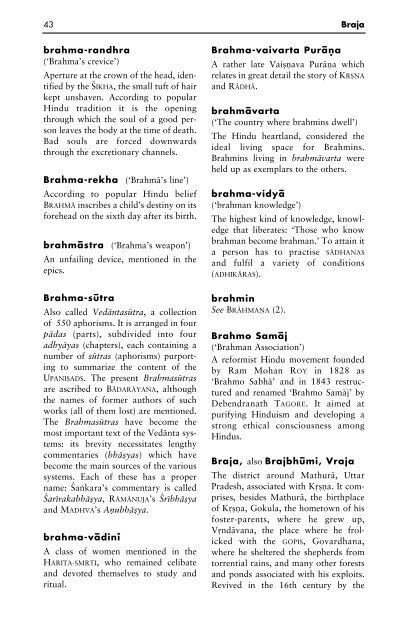A Concise Encyclopedia of Hinduism Klaus K Klostermaie
Create successful ePaper yourself
Turn your PDF publications into a flip-book with our unique Google optimized e-Paper software.
43 Braja<br />
brahma-randhra<br />
(‘Brahma’s crevice’)<br />
Aperture at the crown <strong>of</strong> the head, identified<br />
by the ŸIKHA, the small tuft <strong>of</strong> hair<br />
kept unshaven. According to popular<br />
Hindu tradition it is the opening<br />
through which the soul <strong>of</strong> a good person<br />
leaves the body at the time <strong>of</strong> death.<br />
Bad souls are forced downwards<br />
through the excretionary channels.<br />
Brahma-rekha<br />
(‘Brahmä’s line’)<br />
According to popular Hindu belief<br />
BRAHMÄ inscribes a child’s destiny on its<br />
forehead on the sixth day after its birth.<br />
brahmästra<br />
(‘Brahma’s weapon’)<br />
An unfailing device, mentioned in the<br />
epics.<br />
Brahma-sütra<br />
Also called Vedäntasütra, a collection<br />
<strong>of</strong> 550 aphorisms. It is arranged in four<br />
pädas (parts), subdivided into four<br />
adhyäyas (chapters), each containing a<br />
number <strong>of</strong> sütras (aphorisms) purporting<br />
to summarize the content <strong>of</strong> the<br />
UPANIÆADS. The present Brahmasütras<br />
are ascribed to BÄDARÄYANA, although<br />
the names <strong>of</strong> former authors <strong>of</strong> such<br />
works (all <strong>of</strong> them lost) are mentioned.<br />
The Brahmasütras have become the<br />
most important text <strong>of</strong> the Vedänta systems:<br />
its brevity necessitates lengthy<br />
commentaries (bhä•yas) which have<br />
become the main sources <strong>of</strong> the various<br />
systems. Each <strong>of</strong> these has a proper<br />
name: Ÿaökara’s commentary is called<br />
Ÿarïrakabhä•ya, RÄMÄNUJA’s Ÿrïbhä•ya<br />
and MADHVA’s Aæubhä•ya.<br />
brahma-vädinï<br />
A class <strong>of</strong> women mentioned in the<br />
HARITA-SMØTI, who remained celibate<br />
and devoted themselves to study and<br />
ritual.<br />
Brahma-vaivarta Puräæa<br />
A rather late Vai•æava Puräæa which<br />
relates in great detail the story <strong>of</strong> KØÆŒA<br />
and RÄDHÄ.<br />
brahmävarta<br />
(‘The country where brahmins dwell’)<br />
The Hindu heartland, considered the<br />
ideal living space for Brahmins.<br />
Brahmins living in brahmävarta were<br />
held up as exemplars to the others.<br />
brahma-vidyä<br />
(‘brahman knowledge’)<br />
The highest kind <strong>of</strong> knowledge, knowledge<br />
that liberates: ‘Those who know<br />
brahman become brahman.’ To attain it<br />
a person has to practise SÄDHANAS<br />
and fulfil a variety <strong>of</strong> conditions<br />
(ADHIKÄRAS).<br />
brahmin<br />
See BRÄHMAŒA (2).<br />
Brahmo Samäj<br />
(‘Brahman Association’)<br />
A reformist Hindu movement founded<br />
by Ram Mohan ROY in 1828 as<br />
‘Brahmo Sabhä’ and in 1843 restructured<br />
and renamed ‘Brahmo Samäj’ by<br />
Debendranath TAGORE. It aimed at<br />
purifying <strong>Hinduism</strong> and developing a<br />
strong ethical consciousness among<br />
Hindus.<br />
Braja, also Brajbhümi, Vraja<br />
The district around Mathurä, Uttar<br />
Pradesh, associated with Kø•æa. It comprises,<br />
besides Mathurä, the birthplace<br />
<strong>of</strong> Kø•æa, Gokula, the hometown <strong>of</strong> his<br />
foster-parents, where he grew up,<br />
Vøndävana, the place where he frolicked<br />
with the GOPIS, Govardhana,<br />
where he sheltered the shepherds from<br />
torrential rains, and many other forests<br />
and ponds associated with his exploits.<br />
Revived in the 16th century by the


















